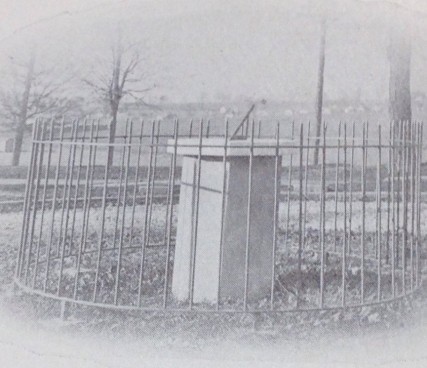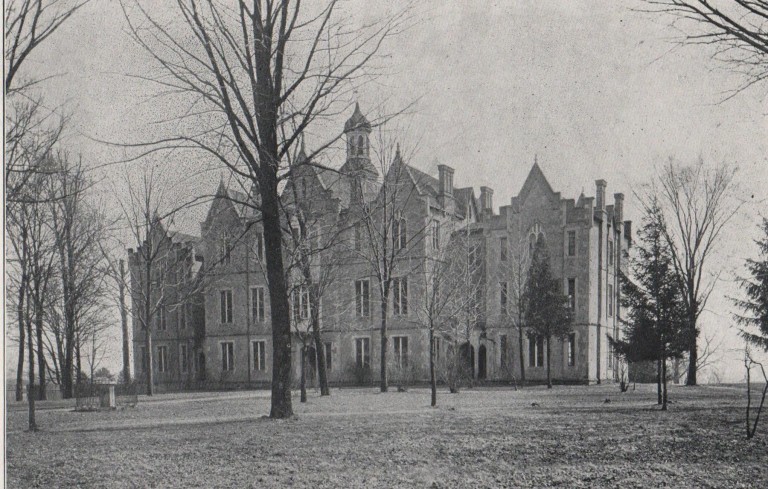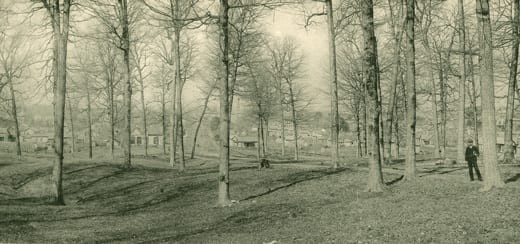The Sundial at IU and Important Points: Lovers Even Into Death
Introduction
Text-to-speech Audio
Visitors to Indiana University have been delighted by the history behind this little sundial as it incorporates the story of love and resilience. In 1868 the graduating class presented IU with the Sundial. Then in 1833, a fire destroyed the campus causing them to move it up on the hill. It wasn't until 1896 that they moved the sundial to the location it currently resides.
Images
Sundial

Old IU campus and sundial

Dunn's Woods

Backstory and Context
Text-to-speech Audio
Cyrus M. Dodd graduated from Williams College in 1855 and went on to teach Latin at Washington and Jefferson College. In 1866 he went to IU to fill an empty math position. The following year the math teacher returned and Dodd was given a position at IU teaching Latin. The idea for the sundial was conceived by Cyrus M. Dodd in 1866-1868. There is no record of when he came up with the idea so the dates provided are the years that he was employed at IU. His employment at IU was cut very short when he got an offer at his alma mater to teach. The same year that Dodd left his students payed the majority of the money that was needed to construct the sundial. Nelle V. Neill Jackson stated that it was her grandfather and his partner (Greenberry Cruse and Mr. Bierly) that " built and sunk [the] sundial.". On the old campus it was located in the center of the main walk way leading to the college entrance. A fun little story about the sundial was one that involves Rev. Dr. Cyrus Nutt the IU president from 1860-1875. It's said that one evening while the sky was starting to turn to twilight, he struck a match at the sundial to see what time it is.
In 1883 a fire swept over the old IU campus. The fire was found out to be caused by lighting striking the telephone wire that led to Theophilus Wylie’s room. Fun fact about Theo, he occupied the Wylie House from 1859 - 1913, which was the home of the first IU president Andrew Wylie his half-cousin. On Thursday July 12th 1883 a little after 10 o’clock, the new college building was found to be on fire and the alarm was given. The Fire Dept. of the town with its new steam fire engine, and its smaller engine, did its best to extinguish the flames. In this attempt it failed but succeeded in saving the old building by keeping the roof and end adjacent to the burning structure soaked with water. Within two hours from the discovery of the fire, the entire roof had fallen in and only the walls with a few clinging timbers remained. The building thus destroyed was three stories in height and was built in 1873 at a cost of $33,000. It contained the Library of 14000 volumes, the Museum in which was the Owen Cabinet of 85000 specimens carefully labeled and displayed in suitable cases, The Ward caste of Extinct Animals, Prof. Jordan’s collection of fishes, and many other valuable collections. The fire wasn't all bad though, IU wanted more space for their growing student base and so they could have more buildings. The old campus was also located next to a railway and that's a noisy distraction that IU was glad to get away from. They more specifically moved to Dunn's woods.
Dunn's Woods was this twenty acre beech and maple forest, with the Jordan River snaking throughout. They decided to develop ten acres of it, so nowadays there are only ten acres of woodlands. Although the land was beautiful it was not the best for building, with its many sinkholes, ravines, and occasionally flooding banks. They wanted to keep the forest full of natives even back in 1896 they said "Native trees should be preferred to foreign trees, both because they are better adapted to the climate and soil, and also because they look more appropriate." Regardless of the actions of the people to keep the forest full of native plants, today it is full of invasive species some of them include winter creeper, Japanese stilt grass, and Tree of Heaven. Today they are working to keep the vision of the campus founders to have a "university in a park".
With all that background info that takes us now to the story of Otto and Mathilda, two IU students whose story is directly linked to the sundial. During their attendance at IU (the year the met wasn't specified anywhere I found) Mathilda Zwicker and Otto Paul Klopsch met at the sundial. This was the start of their budding relationship. Even though they didn't stay in Indiana they did tell their kids stories from their school days including their meeting at the sundial. They were married for 37 years at the time of Mathilda's passing in 1933, her husband followed in 1935. After they had both passed away their son Otto Klopsch, Jr. met with the president at the time William Lowe Bryan and asked him if he could spread his parents ashes at the base of the sundial. This request was happily granted. There is now a plaque that reads "They met at this sundial when classmates. Their ashes rest here together until eternity." I thought this is one of the most wholesome stories I have explored.
Sources
Richardson, Randi . A Lasting Gift from the IU Class of 1868, MONROE COUNTY HISTORY CENTER RESEARCH LIBRARY. March 2nd 2020. Accessed August 15th 2020. https://mchclibrary.wordpress.com/2020/03/02/a-lasting-gift-from-the-iu-class-of-1868/.
Terry. Cyrus M. Dodd, Find A Grave Memorial . July 2nd 2013. Accessed August 15th 2020. https://www.findagrave.com/memorial/113226887/cyrus-morris-dodd.
Dickerson, Ava. 1883 Fire!, Blogging Hoosier History. July 12th 2016. Accessed August 15th 2020. https://blogs.libraries.indiana.edu/iubarchives/2016/07/12/1883-fire/.
Bracalente, Anita . Indiana University’s Woodland Campus (2012), Library of American Landscape History . 2012. Accessed August 15th 2020. https://lalh.org/indiana-universitys-woodland-campus-2012/.
